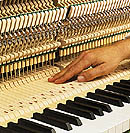THE PIANO ACTION & SCALE DESIGN
(Click on image to see how a grand piano action functions)
Briefly stated, the way a piano action works is that the down pressure on a key is converted to a forward motion of the hammer towards the strings. The hammer travels five times as far and approximately four times as fast as the front end of the key does, the key travel being only about 3/8 of an inch at its front edge. This is accomplished through a remarkable system of levers and pivots which, for a quality piano, must be adjusted to the utmost accuracy, making the action so responsive to the player's touch on the keys that there is almost no limit to the musical effects obtainable. For a better, more natural leverage, piano keys slope slightly downward towards the back and become level when the key is depressed.
A piano action would be a fairly simple mechanism if, when you depressed a key, it just had to push the hammer against the string. But if it worked that way, there would not be much tone because the hammer would stay against the string and, acting as a muffler, would stop it from vibrating. Thus, it would not have had time to return to its starting position after you released it.
Consider the manufacturing problem created by the fact that thousands of the parts in a piano are moving parts, that many are very small and that on some of them a variation of a thousandth of an inch will affect their performance. Not only is the utmost precision required in making and assembling the parts, but they must operate quietly and resist friction, wear and loss of accuracy under long and strenuous use. The materials used today for the best piano actions are largely wood, felt, woolen bushing cloth and leather. Like all products of nature, these items are inclined to be unstable when exposed to varying climatic conditions, although this hazard is greatly reduced in the better pianos by use of the highest quality materials and by superior workmanship.
If metal could be used, it would simplify the manufacturing problems and substantially reduce the cost; however, metal (not being noiseless without frequent lubrication and adjustment) does not lend itself to the purpose and very little of it is employed. Many other materials, including all kinds of synthetics, have been tried, but, with few exceptions, have not proved success, imagine a hinge or bearing that would work smoothly and silently for fifty years or more without lubrication or constant adjustment. Every pivot in a piano action must do this and they do it because these moving parts are held in a circle of specially made material called bushing cloth. Action hinges or pivots are made by boring holes in wooden parts, lining the holes with this bushing cloth, then connecting the adjoining parts with German Silver center pins which will rotate in these cloth bearings virtually without attrition unless exposed to the most abnormal climatic conditions. This cloth, among its many other properties, must be uniform in thickness to an unbelievable degree. The makers allow a tolerance of 2 one-thousandths of an inch, plus or minus, which is less than one-half the thickness of an ordinary business card and is an incredible measurement for such material. It requires a total of ninety-six different operations in the felt mill to produce the superior grades of this cloth used in actions.
To summarize the story about piano actions, good performance is not only a question of superior materials. but also involves skill, experience and the willingness of the piano manufacturer to spend the extra money to have these important hidden parts as accurate and dependable as it is possible to make them.
Copyright © 2015 Bluebook of Pianos All Rights Reserved. Anyone who reproduces copyrighted material improperly can be prosecuted in a court of law. It does not matter if the form or content of the original has been altered -- as long as any material can be shown to be substantially similar to the original, it may be considered a violation of the Copyright Act.

